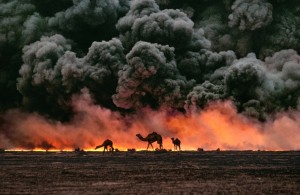What is the 5th Trumpet?
The fifth angel sounded his trumpet, and I saw a star that had fallen from the sky to the earth. The star was given the key to the shaft of the Abyss. 2 When he opened the Abyss, smoke rose from it like the smoke from a gigantic furnace. The sun and sky were darkened by the smoke from the Abyss. (Revelation 9: 1-2)
The 5th Trumpet appears to describe The Gulf War: Burning of the Kuwait Oil Fields (1991). (Photo credit: Steve McCurry, National Geographic)
The Gigantic Furnace
When Saddam Hussein was forced to leave Kuwait, he set more than 600 of the world’s richest oil wells, various oil lakes, refineries, and storage tanks on fire as part of his “scorched earth” policy. The gigantic furnace was very difficult to extinguish because the heat from those fires reached 2,000 degrees.
The burning of the oil wells created so much smoke that it literally blocked the sun in the sky for over 3 months. The first fire started in January 1991 and the last well was capped in November 1991. Due to having to locate and diffuse land mines and the intensity of the heat, it took almost a year to fully contain the burning oil wells. A total of about 1 billion barrels of oil burned. The fires caused widespread pollution. In addition, over 6 million barrels of oil were discharged directly into the Persian Gulf.
The Sting of a Scorpion
3 And out of the smoke locusts came down on the earth and were given power like that of scorpions of the earth. 4 They were told not to harm the grass of the earth or any plant or tree, but only those people who did not have the seal of God on their foreheads. 5 They were not allowed to kill them but only to torture them for five months. And the agony they suffered was like that of the sting of a scorpion when it strikes. 6 During those days people will seek death but will not find it; they will long to die, but death will elude them. (Revelation 9: 3-6)
Many of the soldiers and civilian workers who served in Kuwait (1991) experienced agonizing symptoms that were so unique that a new diagnosis was created: Gulf War Syndrome. The chronic symptoms of Gulf War Syndrome include: fatigue, headaches, memory problems, muscle pain, diarrhea, neurological problems, terminal tumors, skin conditions, fibromyalgia, gastrointestinal disorders, rashes, and functional impairment.[i]
Some symptoms of the Gulf War Syndrome were similar to the sting of a scorpion: intense physical pain in the form of 1) paresthesia – a sensation of tingling, tickling, prickling, pricking, or burning of a person’s skin with no apparent long-term physical effect; or 2) formication – a sensation that resembles small insects crawling on or under the skin which triggers excessive scratching.
Although the intense agony of the symptoms may have lasted only a few months, there have been long-term effects. More than 20 years later, many of the soldiers and civilians who were in that area continue to be affected by unexplained symptoms (e.g. chronic illness, cancer, numbness, tingling, headaches).
The Locusts
7 The locusts looked like horses prepared for battle. On their heads they wore something like crowns of gold, and their faces resembled human faces. 8 Their hair was like women’s hair, and their teeth were like lions’ teeth. 9 They had breastplates like breastplates of iron, and the sound of their wings was like the thundering of many horses and chariots rushing into battle. 10 They had tails with stingers, like scorpions, and in their tails they had power to torment people for five months. (Revelation 9: 7-10)
If someone had never seen a helicopter, they might describe it as resembling locust with breastplates of iron, the faces of men, and the sound of thundering horses.
Helicopters are insect-shaped aircraft made of metal plates and have windows in front that show the faces of men. Helicopter blades are thunderously loud. Often, there are pictures of fierce animals painted on the aircraft.
Persian Gulf War helicopters were generally camouflaged in desert colors: tan, yellow, green, and/or brown. The spinning helicopter blades could resemble a crown. The helicopters carried weapons on its sides and near the tail. Like locusts, helicopters often flew in swarms and left a path of destruction in their wake.
Their King
11 They had as king over them the angel of the Abyss, whose name in Hebrew is Abaddon and in Greek is Apollyon (that is, Destroyer). (Revelation 9: 11)
The angel of the Abyss could have easily worked with a human who was inclined toward destructive behaviors. In Arabic, the name “Saddam” is translated as: one who confronts, one who frequently causes collisions, powerful collider, powerful confronter, crusher, destroyer. Saddam Hussein was known as “The Destroyer.”
The 1st Woe
12 The first woe is past; two other woes are yet to come. (Revelation 9:12)
The 5th Trumpet was the 1st woe. Each of the next two woes will be exponentially worse than the 1st woe.
The world needs to heed God’s warnings.
References:
[i] RAC-GWVI Minutes 2005, p. 70.

Leave a Reply